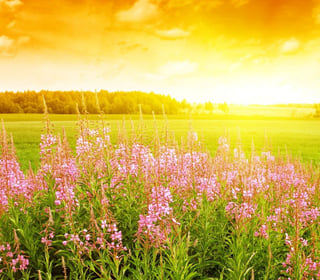July Garden Tips
Written by Matt W (Greenhousestores) on 4th Jul 2018.

Rain is a bit elusive in July, but regardless of that, there is still plenty to do in the garden.
In this guide, we share some July gardening tips so you can still keep your garden in tip-top condition.
Flower Garden Tips
Regularly deadhead flower borders, bedding plants and sweet peas to prolong flowering. In fact, to keep your roses looking tidy, deadhead them too.
After the first growth of hardy geraniums and delphiniums, or English cottage perennials, ensure you cut them to encourage re-sprouting and further blooming. Once they sprout back, they will look so much better, even though they may not flower again.
Some plants have a carpet-like growth habit (e.g. alpines), and they can become patchy at times, with some areas drying off. To encourage regrowth, fill these patches with compost.
Furthermore, to encourage the growth of new flowers and foliage and revive your garden display, cut back growth in hanging baskets.
Look Out for Pests
Check out for vine weevils, aphids that are usually on stems and young shoot leaves. Moreover, be on the lookout for clematis wilt and the scarlet lily beetle that is found on lilies.
Symptoms of clematis wilt include wilting and black discolouration on the leaves and stems. So, make sure that you cut out all the affected material and dispose of it.
During this period, plants have a lot of leaf surface to absorb weed killer easily. So, it is a good time to spray ground elder, bindweed and all other weeds. Also, by spraying a fungicide or pruning out the affected leaves damaged by hollyhock, you stop the foliage rust.
Vegetable Garden Tips
To avoid problems, make sure that you water and feed your tomato plants regularly. Pinch out the side shoots and tie them in canes to provide support. To improve air circulation and prevention from diseases, cut off any leaves growing below the lowest ripening fruit trusses.
July is the ideal time to plant the second cropping potatoes for Christmas. So, plant them in pots or bags that can be brought under cover before the first frost.
To make most of the space available, tie long cucumber stems to vertical wires or a wigwam of poles upwards, instead of them trailing over the ground. On top of that, this is the time to harvest garlic, onions, beetroot, peas, potatoes, carrots, salad leaves and tomatoes.
To encourage branching, nip off the growing tips of squash and courgette. As a matter of fact, the regular picking of courgettes encourages more fruits. On top of that, this month would be the ideal time to do the last sowing of French beans and carrots.
You have to remember to squash any cabbage white butterfly you find under brassica leaves. Also, any diseased and spent foliage should be cleared away and disposed away from your vegetable plants to ensure they are healthy.
Fruit Garden Tips
To avoid the thinning of the stems of apples and plums, you need to pick their fruits regularly. Furthermore, netting around your plants will protect them from birds and squirrels.
Strawberries should be ripening around this time. So, to keep fruits off the soil, ensure there are enough straws. If you need more strawberry plants for next year, peg down the runners on your strawberry plants.
On the other hand, completely remove the strawberry runners if you don’t need more plants. To reduce the risk of trees getting silver leaf disease, prune your plum, apricot, peach and cherry trees. After harvesting, prune the fruited stems of your blackcurrant bushes.
Most importantly:
Regularly harvest your berries before birds get them.
Lawn Gardening Tips
A new lawn should not be allowed to dry. Thus, use a sprinkler to sufficiently water your garden if it does dry up. On top of that, you need to mow your lawn as well regularly.
Because the weather is hot during this month, set the mower at a slightly higher level than you usually would. This is to prevent the lawn from drying due to the heat.
To get rid of the weeds, you are able to use soluble feed and weed products. If spring feed was not given, then this is the time to apply liquid summer fertiliser on your lawn.
On top of that, ants usually infest lawns during this period. So, brush their nests on a dry day. However, this should be done before mowing.
Shrubs
As soon as the blossoms fade, this is the ideal time to prune the summer flowering shrubs, for example, philadelphus and weigela. Furthermore, you have to cut any damaged or dead shoots.
It is advisable that you hold off planting until the fall, but if transplanting is a must, then make sure that you water the plants thoroughly.
Watering
This seems like a basic thing, but it is easy to do it wrong. In fact, it is possible to overwater as well as underwater your plants. Furthermore, you mustn’t just spray one area and then move on.
In most cases, you will find that the water has just gone a few millimetres into the soil and this is not beneficial to both the soil and the plant.
Remember:
You need to water the base of the plant and not the foliage.
Conclusion
It is important to note down the changes you have noticed in your garden to ensure that the following year, you will be able to make the necessary adjustments if need be. That said, follow these tips for when you’re gardening in July to make the process easier for you.